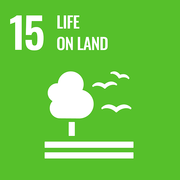
Global biodiversity: how not to lose it
Ambitious efforts are needed to halt the global biodiversity crisis, particularly to protect areas of high conservation value and risk of decline.
An international research team comprising Moreno Di Marco from the Charles Darwin Department of Biology and Biotechnology of Sapienza University of Rome, used advanced geospatial algorithms to map the optimal area for the conservation of terrestrial species and ecosystems worldwide. Using land-use scenarios, the researchers also quantified the land area at risk due to human habitat modification activities.
The study, published in the prestigious journal Science, was coordinated by James R. Allan of the University of Amsterdam and was a collaboration of Sapienza with the University of Amsterdam, the University of Queensland, The Nature Conservancy (TNC), the United Nations Development Programme (UNDP), the University of Cambridge, BirdLife International, the University of Tasmania, the Rights and Resources Initiative (RRI), the University of Kent, the University of Melbourne and the University of Delaware.
The results of this research show that to halt the biodiversity crisis it would be necessary to preserve an area of 64 million km2, which corresponds to 44 % of the Earth's surface. Furthermore, models show that more than 1.3 million km2 of this land area - an area larger than South Africa - is at risk of being destroyed by 2030 by human activities, with devastating consequences for wildlife.
Considering that 1.8 billion people live in the identified areas, conservation actions that promote these populations' autonomy, self-determination, and environmental leadership are essential. To this end, proper instruments range, depending on the local context, from the empowerment of indigenous peoples to regulations limiting deforestation to protected areas.
Because several countries, under the leadership of the United Nations, are currently negotiating new nature conservation targets, this work will have important policy implications. Indeed, the post-2020 action plan of the Convention on Biological Diversity (CBD) - an international treaty adopted in 1992 to protect biodiversity - will come into force later this year. That will set the conservation agenda for the next decade, and nations will have to report on their achievements against the new 2030 targets.
"To date, this research represents," says Moreno Di Marco, co-author of the study and coordinator of Sapienza University's 'Biodiversity and Global Change' research group, "the most comprehensive analysis of biodiversity conservation needs on a global scale and demonstrates that the expansion of protected areas is a necessary but not sufficient measure to reverse the decline in biodiversity. Protected areas must, therefore, be coupled with sustainable land-use planning policies, recognition of the leading role of indigenous peoples, mechanisms for tax transfers to developing and biodiversity-rich countries, and control of industrial activities in areas important for biodiversity".
Although more than a decade ago, nations aimed to preserve at least 17% of the Earth's surface through protected areas and other spatial approaches, by 2020, it was clear that this would not be enough to halt the decline of biodiversity and avert its crisis, not least because of the failure to meet other targets.
"Our analysis shows," Moreno Di Marco concludes, "that the risk to biodiversity from habitat loss in important conservation areas can still be significantly reduced (by as much as seven times!) if sustainable land-use policies are implemented today. However, governments cannot continue to pursue a 'business as usual' economic development strategy".
References:
The minimum land area requiring conservation attention to safeguard biodiversity - James R. Allan, Hugh P. Possingham, Scott C. Atkinson, Anthony Waldron, Moreno Di Marco, Stuart H. M. Butchart, Vanessa M. Adams, W. Daniel Kissling, Thomas Worsdell, Chris Sandbrook, Gwili Gibbon, Kundan Kumar, Piyush Mehta, Martine Maron, Brooke A. Williams, Kendall R. Jones, Brendan A. Wintle, April E. Reside, James E. M. Watson - Science (2022) https://doi.org/10.1126/science.abl9127
Further Information
Moreno Di Marco
Charles Darwin Department of Biology and Biotechnology
moreno.dimarco@uniroma1.it
